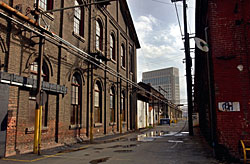
If a plan to redevelop the railyard is realized, the alley next to the old manufacturing building at left could be alive with diners, concert-goers and residents. Right now, the only sign of life is the federal courthouse in the distance.
Sacramento Bee/Jay Mather
Thinking big
Railyard developers want to turn old workshops into a vibrant
center of modern urban life
February 29, 2004
© Sacramento Bee
"You can almost hear it: clang, clang, bang, bang, screech, screech," he exclaims. "That's the kind of thing you can't buy in a new building."
A former project manager for Disney's theme park division, Rich spent years trying to create an authentic mood for rides such as Splash Mountain at Walt Disney World.
His task today is far different, but certainly no less challenging. Rich, 49, is local project manager for Millennia Associates, the group working to redevelop the closed downtown railyard. The shuttered industrial complex is certainly authentic, but it will cost many millions of dollars to bring into the modern age.
Millennia has yet to submit a formal proposal to the city, but the broad outlines have emerged for a development that would include 4,500 housing units, offices and shops. Whether or not the city will ask the partners to make room for a new arena for the Kings remains to be seen.
Rich last week revealed the partnership's plan to turn several former shop buildings into a public market and entertainment center along the lines of Faneuil Hall Marketplace in Boston. Housing units would go upstairs in the planing shop and the car machine shop.
A 52,000-square-foot public produce market would go in the old paint shop, whose walls are lined with graceful brick arches where train cars once entered. The arches, many of them since covered with doors or glass, would be opened up so people could stroll in and out.
"This building would represent the produce and the products of the whole Central Valley," Rich said.
Rich, who lives in Los Angeles, spends several days a week in Sacramento advancing Millennia's efforts to buy the 240-acre railyard from Union Pacific.
"We're betting millions of dollars that it's going to happen," Rich said of the UP sale. He said a formal development application would be filed with the city "within weeks" of a signed deal with the railroad.
The city recently assigned one of its top planners, Carol Shearly, to oversee the railyard effort. Shearly has been managing the city's most significant development: the explosive growth in North Natomas.
"I'm really excited about the project," Shearly said. Plans to redevelop the railyard have come and gone for a decade, and, Shearly said: "It's really neat to finally see it getting started."
Aside from the old shop buildings and the considerable toxic contamination that remains to be cleaned up, the railyard in many ways resembles a new development like North Natomas, Shearly said. It needs new streets, new sewers, new utilities - pretty much new everything.
Based on her experience with Natomas, Shearly predicts it will be at least two years before construction begins, and five years before it is going full-steam.
The reuse of the shops as an urban center for the new neighborhood is a key component of Millennia's plan, Rich said.
"The idea of being able to take these buildings and bring them back to life and reintroduce them to downtown, it's like a gift to have that opportunity."
Little public attention has been paid to the cluster of five historic shop buildings that Millennia will have at its disposal if it succeeds in buying the railyard.
There are seven shop buildings remaining, but two of the largest - those used for building and repairing steam and diesel engines - have been promised by UP and Millennia to the California Department of Parks and Recreation for a Museum of Railroad Technology.
In the buildings that remain, thousands of workers once built railroad coaches and cars, created wheels, sewed seats and even plated silver for use by train passengers.
Mostly constructed of red brick, the buildings have soaring ceilings buttressed by wooden or metal trusses. They're the kind of old industrial buildings that in many Eastern cities have been turned into fashionable shops, lofts and arts facilities.
Under Millennia's plan, the paint shop-turned-public market would be flanked on the east by a public plaza. The plaza in turn would connect to new street-level stores and upstairs housing units Millennia plans for the extension of Fifth Street, which would cross the railroad tracks on a bridge.
"This would be a hopping civic place all the time," Rich said as he stood on the spot, now a bare patch of concrete.
To the west of the paint shop, the former car shop, planing mill and car machine shop would become restaurants, nightclubs, arts and cultural venues. Millennia hopes to convert the upstairs of the planing mill and car machine shop to housing. These buildings are linked by an enclosed wooden bridge built around 1900.
It could be difficult and expensive to restore some of the more than century-old structures, Rich acknowledged. While the paint shop remains in pretty good shape, the cavernous car shop visibly leans.
"This is the big question mark," Rich said of the car shop. "It may fall down before we have a chance to fix it."
The picturesque, three-story brick restroom also leans, but Rich is less worried. It is small and could be preserved for ambience, without any use inside.
"It leans, but that's part of its special character," he said.
While the shops didn't completely close until 1999, work had dwindled for years before that, and some of the buildings have a long-abandoned feel.
Leading a tour of the planing mill and car machine shop, Rich had to step around a dead skunk that had gotten caught in the door.
Upstairs, pigeon dung several inches thick coated much of the floor. Foam used for railroad seat cushions still lay around on tables, along with a 1988 order for seat covers. Long strips of peeling paint hung from the ceilings and walls.
Rich excitedly pointed to a gap in the artificial ceiling that revealed high, vaulted space under the roof. "If you strip out those ceilings, you have some of the most dramatic space in Sacramento," he said.
Crumbling bricks aside, one of the biggest potential obstacles Millennia faces in carrying out its plan for the railyard is opposition from existing downtown merchants. These business owners are wary of new retail development drawing shoppers away from Downtown Plaza and the K Street Mall, which the city has spent millions of dollars to redevelop.
Millennia is led by architect Jon Jerde, who is responsible for providing the overall vision for the development. In recent years, Jerde has designed mixed-use developments that include housing. But he is best known for his work on shopping centers, including Horton Plaza in San Diego and Downtown Plaza in Sacramento.
The railyards project would encompass 620,000 square feet of retail space, including the public market, Fifth Street and neighborhood stores, Rich said. That's about half as much as Downtown Plaza.
"We're watching the retail part of it very closely," said Anthony Manos, executive vice president of commercial and mixed-use development at Westfield, the Australia-based owner of Downtown Plaza.
Four years ago, developer Mills Corp. floated the idea of a new 40-acre retail, entertainment and housing district in the southern part of the railyard, only to leave town saying they had been discouraged by the city. Mills officials said it was clear the city would not support a project with theaters and stores competing with K Street.
Rich said Millennia is trying to avoid the same fate by emphasizing the 4,500 housing units it plans to build and working closely with The Downtown Sacramento Partnership, which represents existing businesses.
Michael Ault, the downtown partnership's executive director, said the group appreciates Millennia's direct, open approach.
"I think we can work with them to make sure that the retail they do makes downtown a larger place instead of creating another destination that competes with downtown," Ault said.
Rich said that expanding downtown dining, shopping and entertainment options will help K Street, not hurt it.
"When you look at K Street inside a heavy, dashed line and you try to improve just that piece, you've got a tough job," he said. "Outside that line, you've got 6 million square feet (of retail) in the suburbs that pulls people out."
What downtown needs, he said, is a "district that has the energy to attract 10,000 new residents. ... Then it will be like Denver or Portland or San Diego."
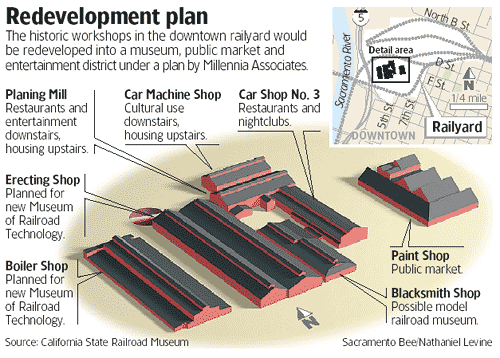
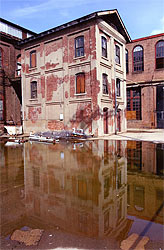
A vacant three-story brick restroom could be preserved under Millennia Associates' plan for the railyard.
Sacramento Bee/Jay Mather
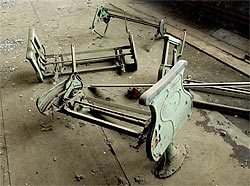
Frames for rail car benches are a legacy of the time when the railyard was an important manufacturing center.
Sacramento Bee/Jay Mather
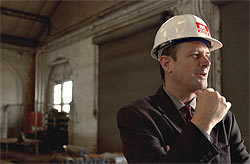
Richard Rich, Millennia Associates' project manager, loves the area's 19th-century feel.
Sacramento Bee/Jay Mather
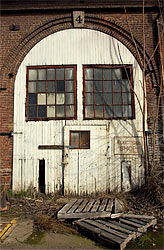
The graceful brick arches where trains used to enter the workshops, like the one above, would be opened up for pedestrians under the plan that Millennia has developed. "We're betting millions of dollars that it's going to happen," Rich said.
Sacramento Bee/Jay Mather